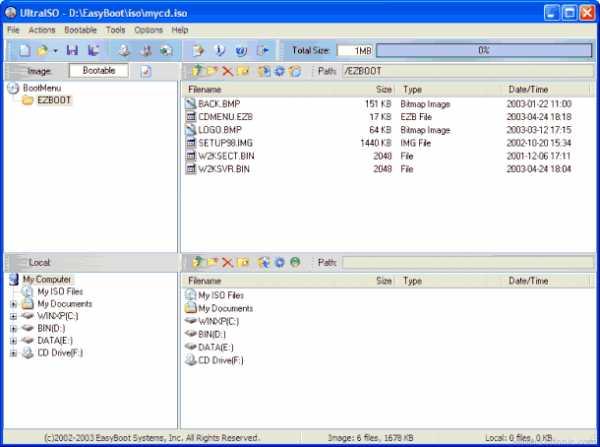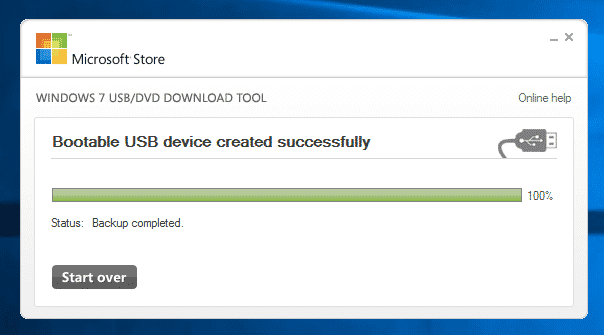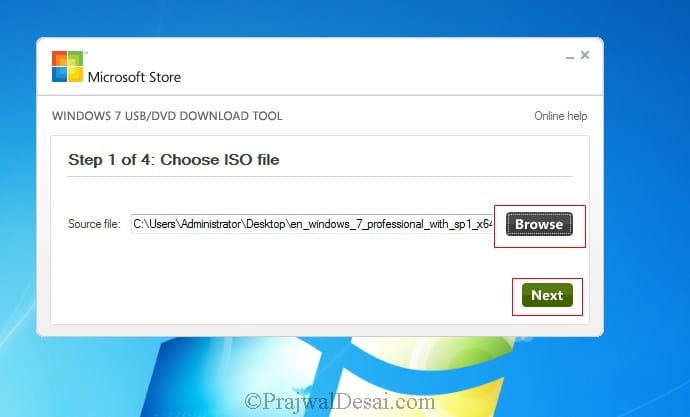Using a Bootable USB device you can access advanced options and perform diagnostics on Windows PC that having trouble booting from the hard drive. Also, you can use a Bootable USB drive to clean install Windows 10 instead of using the Windows installation CD. Here simple easy steps to create windows 10 installation media using the official media creation tool, and third-party utility UUByte ISO Editor.
Windows 7 USB DVD Download Tool is the native, free, and simple utility tool to create Windows DVDs or USB flash drives. The program supports the creation of bootable 64-bit and 32-bit operating systems. When you download and install the software on your PC, you get access to a decompressed ISO file or a collection of compressed files. The tool has been developed by Microsoft Corporation to install the ISO file on a Windows computer. ImgBurn is a comprehensive ISO creation and burning software with a lot of extra functionality.
It was primarily designed for building DVD video disks, but it's actually a lot more than that. The biggest downside is that it might seem too complex for first-time users who have little experience with ISO files or OS installations. However, all it takes is a basic knowledge of the steps involved.
Here, we show you how to create bootable Windows 10 media using ImgBurn. Making bootable USB drive for Windows 10 using your flash drive or pen drive is quite easy and you can achieve it by following the steps shown below in this guide. This is the old and still reliable method to create windows 10 installation media for Windows Installation.
Users can easily make a bootable disk from an iso image file with this utility. Windows 7 USB DVD Download Tool is a freeutility program that creates bootable USB flash drives or DVDfor Windows and 64-bit operating systems. I used it exactly as you suggested on a Windows 7 system. Input was the 3 gb Windows.iso file created by the MSFT media creation tool. Rufus's bootable image output file fit onto a 4 gb USB flash drive.
Looking to Create a Bootable USB drive or Windows Installation media for Windows Upgrade Or Clean installation Purpose? Also some times ee require a Windows 10 installation Media to Access the Advanced Startup option to fix windows Startup problems. With Rufus all it took was just 1 button.
No cmd and all that complicated stuff. On Windows 10, you can use at least two tools to create a USB bootable media. You can use the Microsoft Media Creation Tool to download the files onto a removable storage with support for both firmware types . Or you can use Rufus, a third-party tool that makes it easy to create a flash drive to install Windows with support for UEFI. Now, you need to boot from the USB device you just created to start the Windows installation process. If your computer doesn't boot from it, you might need to change the boot order.
To overcome this, you should make sure that your device is formatted as FAT32 and your computer has enough disk space. Rufus is a utility that helps format and create bootable USB flash drives, such as USB keys/pendrives, memory sticks, etc. Despite its small size, Rufus provides everything you need! It is also marginally faster on the creation of Linux bootable USB from ISOs. Windows USB DVD Download Tool gives simple instructions to create a bootable version of Windows operating systems.
You only need the ISO file and a flash drive or DVD-R. The program requires you to follow only a few steps, and there are multiple forums to guide you through the process. Since this program has been developed by Microsoft Corporation, you don't have to worry about the tool's stability and reliability. Windows 7 USB DVD Download Tool is an official software program provided by Microsoft.
Windows 7 USB DVD download tool is used to create a bootable DVD or USB flash drive from the downloaded ISO file. By doing this, you can install Windows 7 directly from the USB drive or DVD. The ISO file contains all the Windows 7 installation files combined into a single file.
To begin, prepare a 2GB thumb drive and proceed to download the latest .iso version of the Linux or Windows operating system for desktop PCs and laptops. Below is a list of the most popular OS in .iso format. It requires ISO image file of the windows. Select the ISO image and start the process.
You can download the iso file of windows 10 using media creation tool as mentioned in method 1. Rufus is free tool to create bootable USB drives. It's a very light utility that helps format and create bootable USB flash drives. It is also available as portable installer.
To download the latest version of Rufus tool, click here. In windows we will use the windows usb dvd download tool, a free software provided by the Microsoft itself. In Ubuntu Linux we will use the WoeUSB tool, a free USB bootable software for Linux. With Windows 10, however, the tool doesn't always act the way it should. For example, if you're trying to create bootable media for Windows 10 on another Windows 10 computer, it won't always work.
That's because the tool wasn't designed to be used on a Windows 10 PC since Windows 10 has its own native ISO burning utility. As you can see from the below screen, the progress bar says 100% but it never finishes. Once you inserted the USB into the computer, it says no bootable device found.
Luckily, there are several better alternatives that you can use for Windows 10 installations and on Windows 10 systems. On the choose media type screen, select USB device to create a bootable Windows installation flash drive. The copy of the ISO file that the Windows 7 USB/DVD Download tool Latest Version creates is bootable. Bootable media enables you to install Windows 7 without having to first run a current operating system on your own machine. Please begin to see the documentation for your personal computer for information on the best way to change the BIOS boot order of drives. Microsoft released its official ISO to USB utility called Windows USB/DVD Download Tool after Windows 7 was publicly available.
It has long been a favorite of Windows enthusiasts to create bootable Windows USB or DVD for system install or repair. It was originally created for the Windows 7 environment, but a lot of users have been creating Windows 8 and Windows 10 bootable media with the tool. The copy of the ISO file that the Windows USB/DVD Download tool creates is bootable.
Bootable media allows you to install Windows 7 without having to first run an existing operating system on your machine. Please see the documentation for your computer for information on how to change the BIOS boot order of drives. On the insert USB device screen, select your USB flash drive or the external hard drive to which you want to copy the setup files and click Begin copying. If your USB device does not have enough space, you will be shown a dialog box saying so. This will format your USB device and delete all data on it. Now, you need to boot from the USB device you just created to start the Windows 8.1 installation process.
Also, you must note that older computers won't boot from a USB drive that is formatted as NTFS. To overcome this, you should make sure that your device is formatted as FAT32 and your hard disk has enough free space. Even though Microsoft hasn't updated Windows 7 USB/DVD Download Tool since its initial release, it's fully compatible with Windows 8 and Windows 8.1 versions.
Physical DVD drives have become a thing of the past as the size of our PCs continue shrink and new form factors have emerged. Microsoft distributes Windows 10 online as ISO images that are typically burned to physical DVD media. This has become problem as a number of laptops and tablet PCs no longer ship with DVD drives.
The best way to install Windows on these devices is to use a USB flash drive that contains the Windows installation files. As an extra benefit, modern USB flash drives are typically much faster than DVDs resulting in a quick install. Windows 10 on your computer but the device doesn't have an optical drive? Perhaps you're using a laptop without a built-in DVD drive, or even an old netbook or Windows tablet. Whatever the case, you'll need to Create a Bootable USB for windows 10.
And you can do this without any extra software , or you can use tools provided by Microsoft and third parties. Here we have steps to create a bootable UB for Windows 10 installation using Command prompt and using Microsoft's Windows 10 USB Installer Tool. The copy of the ISO file that the Windows 7 USB/DVD Download tool creates is bootable.
Now you have created a bootable windows 10 USB pen drive. Next step is to install windows 10 from USB drive. Although the program's name makes it feel that it only supports Windows 7, that isn't really the case. It works well for preparing a bootable USB device for installing Windows 8 as well.
The boot menu can be personalized with folders, files and other items that are useful for the diagnostics. Unfortunately, you cannot preview the menu which means that you have to keep track of the inserted items. The recovery disk can be saved as an ISO file for burning it to a DVD or by creating a bootable disk from a removable USB device. The app automatically detects the connected USB device and turns it into a bootable recovery toolbox. RMPrepUSB is a user-friendly Windows graphical front-end which calls it's brother application RMPartUSB (which does all the hard work!).
When you purchase Windows from Microsoft Store, you have the option to download an ISO file or compressed files. The Windows USB/DVD Download tool allows you to create a copy of your Windows ISO file on a USB flash drive or a DVD. To create a bootable DVD or USB flash drive, download the ISO file and then run the Windows USB/DVD Download tool. Once this is done, you can install Windows directly from the USB flash drive or DVD. The ISO file contains all the Windows installation files combined into a single uncompressed file.
When you download the ISO file, you need to copy it to some medium in order to install Windows. This tool allows you to create a copy of the ISO file to a USB flash drive or a DVD. Once you complete the steps, Rufus will run the automated script to download the Windows 10 ISO file from the Microsoft servers. Then you can use the tool to create a bootable media to install Windows 10 on a UEFI device without the need for the Media Creation Tool. The utility offers two ways to make the installation media, including using an existing ISO file or downloading the image from the Microsoft servers directly from the app.
When you purchase Windows 7 from Microsoft Store, you have the option to download an ISO file or compressed files. The Windows 7 USB/DVD Download tool allows you to create a copy of your Windows 7 ISO file on a USB flash drive or a DVD. To create a bootable DVD or USB flash drive, download the ISO file and then run the Windows 7 USB/DVD Download tool. Once this is done, you can install Windows 7 directly from the USB flash drive or DVD.
Also, look at an advanced ISO/DVD to USB tool named Rufus. This utility helps format and create bootable USB flash drives, such as USB keys/pen drives, memory sticks, etc. Since the availability of USB drives, the use of CD and DVD has prominently declined. The major reasons behind this are the ease of use, portability, larger capacity and faster copying of data files by the USB drives in comparison to the older methods.
All you need is a flash drive with a capacity of more than 4GB, although 6 to 12 GB available space is ideal for storing additional files as well. Create a bootable USB drive and keep it in a safe place that you can use this disk to easily fix the installation issues. The ISO file contains all the Windows 7 installation files combined into a single uncompressed file. When you download the ISO file, you need to copy it to some medium in order to install Windows 7.
Installing Windows 10 on a PC has become very simple. To start with you need a Windows 10 ISO file, a pen drive that can hold the Windows 10 installation files (at-least 8GB size). And finally a tool that can create a Windows 10 bootable media. If your computer lacks a DVD drive, you can use a USB flash drive to install Windows 10/7 to your PC. Creating a windows 10 boot USB is not difficult. In this tutorial I am going to explain how to make Windows 10 bootable USB flash drive within both Windows and Ubuntu operating systems.
This is a dedicated tool for creating bootable USB drives with ISO files, but it's not very popular since a lot of other tools have come to the market. It hasn't gone past version 1.1 so don't expect regular updates. However, it's a decent enough tool in a pinch, and it is available for both 32-bit and 64-bit Windows 10 architectures. Followed all steps but win to usb says cannot find bootable image after selecting the iso file.



















No comments:
Post a Comment
Note: Only a member of this blog may post a comment.